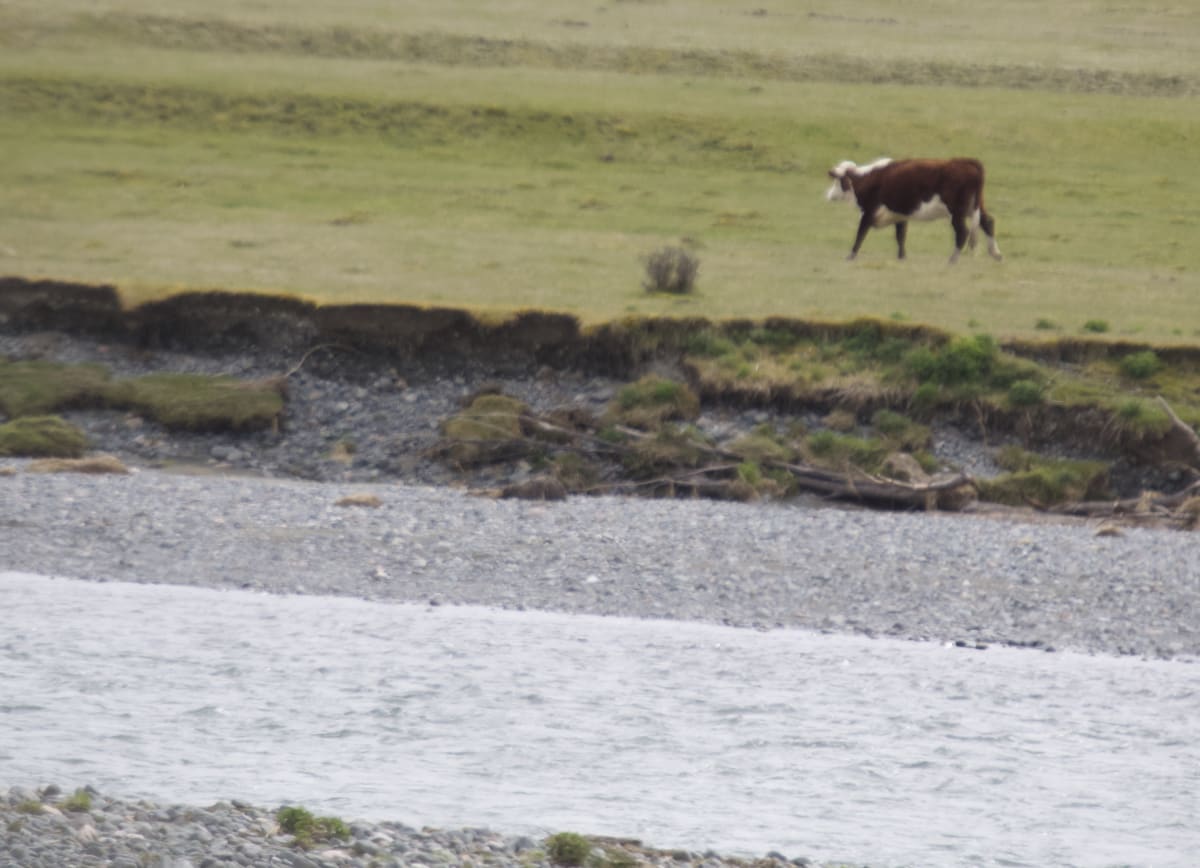‘Negligent’ DoC Lets Cattle In National Park
Environment
Taxpayers spend $362,000 on a kilometres-long fence to keep a farmer’s cattle from a national park. David Williams reports
It’s a proud and straight-forward statement.
“There is no stock grazing within Fiordland National Park,” the park’s 2007 management plan says. The problem is it’s not true – and the Department of Conservation knew it.
The park plan states the last bastion of grazing in the national park was sheep in the Eglinton Valley – that is, until a deal was struck in 1998 to remove them.
What the park plan doesn’t state, but DoC admits now, is that deal with Te Anau Downs Station contained a very important caveat.
“This agreement noted the inevitability of cattle accessing the national park until a boundary along the Eglinton River was fenced,” DoC’s Te Anau operations manager John Lucas said in a statement on Friday afternoon.
Newsroom knew this already because Te Anau Downs Station owner Peter Chartres sent us that exact quote a day earlier.
It took until August of this year – 23 years after the sheep-excluding agreement was signed – for a 14.5km fence to be completed. Lucas confirms taxpayers paid for all of it – a cost of $361,639.
And the cattle are still able to access the national park, for now. Te Anau Downs has until the end of March to remove them, Lucas says – again, something Chartres had already disclosed.
“The cattle are grazing on exotic grass which was established there when this area formed part of Te Anau Downs Station,” Chartres emailed on Thursday, adding “The area has been extensively grazed since 1859.”
That may be the case, but the national park plan says the department will take action to prevent “illegal grazing of stock and other domestic animals”. “Where Fiordland National Park adjoins freehold land, which is grazed, effective control of stock will be sought through discussions with landowners and appropriate fencing.”
The situation in the Eglinton raises several questions.
Can DoC seek side agreements that seemingly flout its own national park management plan? Can cattle graze without a licence, a potential breach of the department’s general policy for national parks?
Has DoC monitored the damage done by Te Anau Downs’ cattle on native species in the park? (DoC didn’t answer this question.) And isn’t paying for the fence setting a terrible precedent by paying for a fence to keep someone else’s stock from entering a national park?
It certainly seems to jar with a decision taken earlier this year by DoC director-general Lou Sanson to cancel a controversial grazing lease in South Westland, after the farming family that held the lease in the upper Haast River valley argued a requirement to fence their cattle out of the Mt Aspiring National Park was expensive and impractical.
“It’s a form of negligence,” says environmental activist Angus Robson, of Matamata, who has taken an interest in the activities of Te Anau Downs Station. He accuses DoC of folding to avoid a showdown.
“Chartres is renowned in that district for making life difficult for regulatory agencies – whether they be regional councils or district councils or DoC or anybody else – they just take the easy way out. And it’s not their money.”
Fiordland National Park is the country’s biggest, spanning more than 1.2 million hectares. It was formally constituted in 1952, and is part of Te Wāhipounamu – South West New Zealand World Heritage Area.

This situation came to light because Newsroom was provided footage of cattle emerging from the national park.
It was shot by environmentalist Matt Coffey, of Queenstown, who was aghast cattle were wading across the Eglinton River into the park in areas where he’d seen nationally endangered black-fronted terns (tarapirohe), nationally critical black-billed gulls (tārapuka), and nationally vulnerable banded dotterels (tūturiwhatu).
“There’s just so much in that valley,” Coffey says.
Robson’s upset taxpayers paid for the fence. “[That money] would have bought a big 1080 drop to save some very, very seriously threatened bush somewhere else in the country,” he says. “It’s almost like they’re scared of [Chartres] and they don’t want to deal with him.”
Te Anau Downs Station has come to the attention of regulators in recent years.
In July last year, the Environment Court granted an interim enforcement order against Chartres and company CP Trustees Ltd to immediately stop clearance, modification or removal of indigenous vegetation at the 8500-hectare station.
The order was sought by Southland District Council, which said: “Despite endeavouring to work with Mr Chartres over the years, continued non-compliance and unlawful clearance has continued on the station which risks irreparable environmental damage and substantial loss of significant indigenous vegetation.”
Clearance over the previous two winters had allegedly caused irreparable damage to significant flora and fauna covering about 800ha – more than four-and-a-half times the size of Auckland’s Cornwall Park.
RNZ reported last year: “Chartres denies he has done anything wrong and plans to oppose a permanent court order the council is applying for.” The proceedings are ongoing.
In June this year, Robson complained a wetland had allegedly been drained on Te Anau Downs. Chartres told RNZ the “ditches” were originally dug by his grandfather in 1936. Environment Southland visited the farm two days later.
The regional council’s general manager of integrated catchment management Paul Hulse says its investigation found work had been done on an existing authorised drain. Maintaining existing authorised structures within a wetland is permitted under certain conditions.
However, the farmer didn’t notify Environment Southland of its maintenance – a breach of regulations under the National Environment Standard for Freshwater. “Based on the seriousness of the breach, and applying the council’s enforcement policy”, Hulse says the landowner was issued an official warning on October 30. (Newsroom has seen the warning, and it was dated October 13.)
Environment Southland also visited Te Anau Downs on August 5, after a complaint about illegal spraying of a wetland. No evidence of illegality was found, Hulse said. “An inspection of the plant species in the area found they were alive and growing as was expected for the time of year.”
“As the fence is along a national park boundary DoC paid for the fence.” – Peter Chartres
It was also in August that the taxpayer-funded fence designed to keep Te Anau Downs stock from Fiordland National Park was completed.
Lucas, the DoC Te Anau boss, says an agreement to fence the boundary was reached with Te Anau Downs in 2019. Initially, the farm station didn’t support the idea, but agreed a ‘give and take’ fence deal once the department offered to pay for it.
“The Fencing Act does not apply to national park boundaries,” Lucas explains. “The Department had no legal options to compel Te Anau Downs Station to pay for a share of the fence.”
Chartres said via email: “As the fence is along a national park boundary DoC paid for the fence.”
Te Anau Downs spans more than 8000ha, environmentalist Robson grumbles. “He doesn’t need any more area.”
Section 60 of the National Parks Act says it’s an offence if someone “causes or allows any animal owned by him or under his control to trespass on any park”, without permission from the minister. Any animal found trespassing may be seized.
Lucas, of DoC, said construction of the Eglinton fence was delayed because of floods in December 2019 and February 2020, and then the Covid-19 national lockdown. Stock were originally agreed to be removed by the end of last year, but because of the delays that was extended to March next year.
“We are very pleased to have resolved this longstanding issue of stock having access to Fiordland National Park,” Lucas says.
Regarding the Cowan grazing licence in South Westland, Conservation Authority chair Edward Ellison wrote to Conservation Minister Kiritapu Allan earlier this year complaining of the previous 21 years cattle had grazed the upper Haast, “only three years have been under a legal grazing licence”.
Ellison went on: “The lack of regulation by the department over the past two decades has resulted in considerable damage to the environment and to the authority’s trust in the department’s regulatory practices.”
One wonders what the authority chair would make of DoC’s indecisiveness in the Eglinton.




